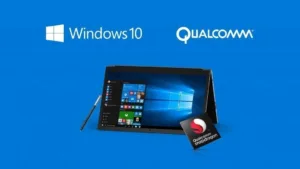The father of the PC was IBM and so we suppose Microsoft was the mother. The godfather of the PC may turn out to be Qualcomm if what we saw in Taipei is any indication.

At WinHec in December 2016, Microsoft said at the time that Windows 10 would (and was) run(ing) on an ARM processor, a Qualcomm Snapdragon 820 to be specific. Between then and now, the eSIM standard got adopted by more carriers, and Intel’s modem group, and the enthusiasm swelled with every new announcement. Qualcomm then introduced the Snapdragon 835 and hinted at a PC using it. For folks like us that try to connect the dots, it was clear that something big was happening, but the skepticism of a tiny ARM processor running a bulky legacy-based OS like Windows with the thousands of apps and add-ons attached to it seemed far-fetched even for the most brazen and naive marketing person.
And then we went to Taipei and met with Don McGuire, VP of Product Marketing at Qualcomm, and Matt Barlow, CVP of Windows Marketing. They not only told us it was happening, but showed it to us. Only one word describes it—A-mazing.
The demos, which we tested and challenged, were lightning, fast, totally robust, and indistinguishable from what we’re used to running on an x86 PC.
Backing up the announcement at Computex were three heavyweight PC makers, Asus, HP, and Lenovo, declaring their total commitment to this new class of PCs. The other traditional PC suppliers are going to be right behind them and are managing their existing product roll out schedules.
Initially Qualcomm is the processor supplier, but other ARM-based SoC suppliers like MediaTek, Nvidia, and Samsung will certainly get involved, and just guessing, Samsung will probably be the second company to do it, most likely coming out with a Samsung, always on PC.
However, Qualcomm is of course not sitting still, and we expect to see a family of processors for the AOPC, just as Intel and AMD have a family of x86 processors for the WinTel version. Qualcomm also has the advantage of a built-in 5G capable modem, and that will give them a lead time and cost advantage for some time.
But aside from the competitive developments, the concept of a PC that, like your phone, doesn’t use too much power and brings the internet/cloud to your fingertips all day (and we’re talking about a 20-hour day), is going to completely turn the PC market around from its slowly sinking unit shipments to a growth market again.
We spoke with Gartner and IDC about this, and how to categorize it, and they are both totally committed to calling it a PC—it runs uncompromised Windows 10; end of discussion.
We also asked the Qualcomm and Microsoft people if this was a reaction to rumors about Apple coming out with an ARM-based Macbook, and/ or rumors about the next gen Android Chrome book. The answer was no, not in any way. Microsoft as you well know, has had versions of Windows running on ARM for years. Yes, they were compromises, and not many people embraced them. But, at the very least, they were an exceptional laboratory for Microsoft. And as the company has demonstrated since its inception, it may not be first, and the first one they do may not be so great, but they will keep coming back at it, and by version three its usually pretty damn good. Windows 10 on Qualcomm is more than pretty good.
For developers, Microsoft has built a super-easy SDK, with checkboxes for the target CPU, and ARM is a default choice. Two runtime version will generated and then the appropriate one will be downloaded automatically from the Microsoft store. And, these are fully qualified version that will run in enterprise to consumer machines.
You may be able to get your hands on one by the end of the year, but more likely, it will be 1H’18. In the meantime, you will have amazing new thin and light WinTel laptops with gen 9 Intel processors and new AMD Ryzen processors. Now, if all this doesn’t stimulate the market, what the hell would? Jon Peddie
This article is re-published with kind permission of Dr Jon Peddie and was originally published in ‘Jon Peddie’s Techwatch‘ Jon has recently a book “Augmented Reality: Where We Will All Live” published by Springer and available on Amazon.

